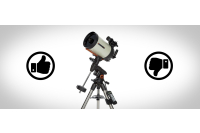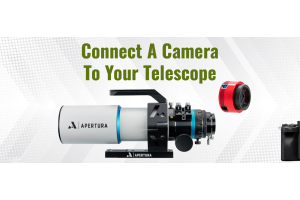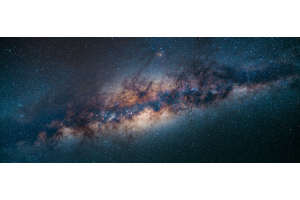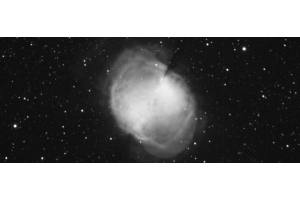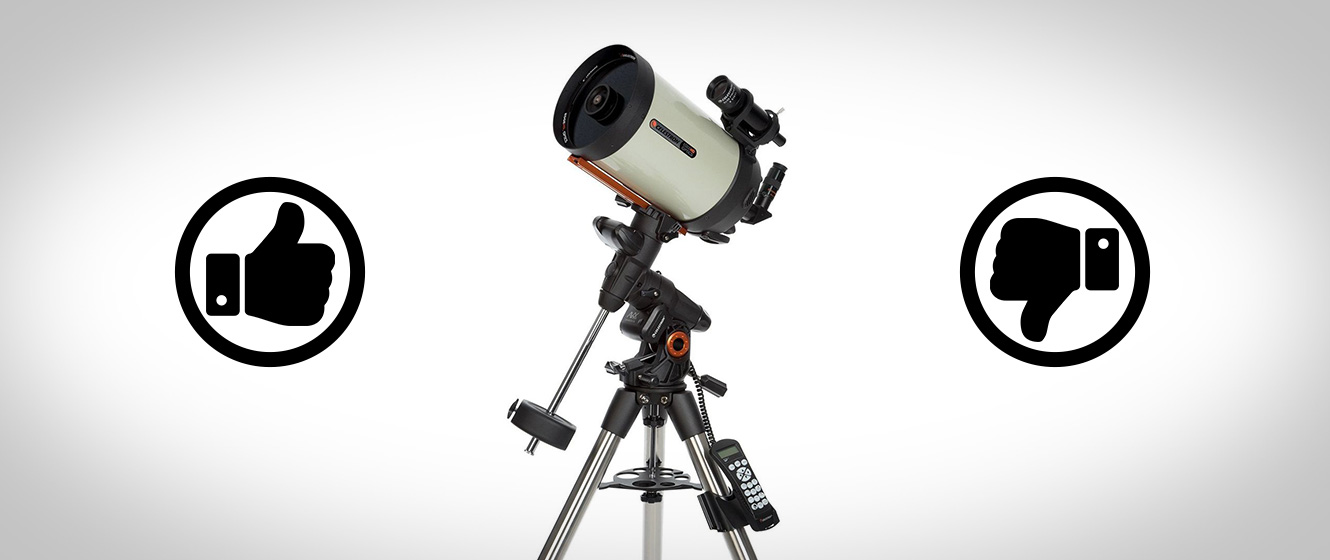
What is a Catadiopritric Telescope?
A catadioptric telescope is an optical system that is optimized for producing images of objects at an infinite distance, incorporating both refractive optics (lenses) and reflective optics (mirrors). Because both mirrors and lenses are used in catadioptric optical systems, the user obtains certain performance advantages over other types of scopes. This also gives telescope manufacturers advantages in the manufacturing process which benefits the consumer indirectly.
As a solid option for a beginner telescope, catadioptric telescopes have been popular with amateur astronomers for a long time. There are several different optical designs which fall into the catadioptric category, but they all have similar performance benefits. They may provide better aberration correction than other all-lens (refractor) or all-mirror (Newtonian reflector) telescopes over a wider aberration-free field of view. Read our catadioptric telescope buying guide below to learn some of the pros and cons of choosing this type.
The Pros of Catadioptric Telescopes
1. Catadioptric telescopes use a folded-path optical system and thus can be shorter than their focal length would imply.
2. They are lighter and more compact when compared to telescopes of the same aperture, as is the mount that holds them.
3. Catadioptric telescopes are convenient to transport due to their mechanical size and reduced weight.
4. Their ability to use mirrors with purely spherical figures and easily reproduced refractive elements, usually called corrector lenses, results in lower manufacturing costs. The manufacturer can thus lower the purchase price for consumers.
The Cons of Catadioptric Telescopes
1. Catadioptric telescopes become heavier rather quickly as they increase in aperture.
2. They may require more frequent optical alignment when compared to refractors.
3. A catadioptric telescope's moving parts are more complex than those found in refractor or reflector telescope.
4. Catadioptric telescopes have an inherent optical performance limitation based on the central obscuration of their aperture caused by their own secondary mirror. However, classical Cassegrain and Newtonian reflecting telescopes share this problem. The "limitation" is very subtle, so most amateur astronomers do not even notice or care about this detail.
There is No Perfect Telescope Design
There is a fundamental truth about optics that has been quoted by opticians and optical engineers for a long time, almost as if it were a mantra:
"Every optical design is always a compromise!"
Although it is tempting to consider this statement trite, it is certainly true, and this "truth" is applicable to astronomical telescopes. In this era of computerized-digital design-assisted technology and elaborate ray-tracing programs, it is easy to be convinced that miraculous optical designs are now possible. That is wishful thinking. The reality is that optical physics and mathematics will remain the limiting technical factors when considering an optical instrument's performance.
This telescope buying guide is not intended to suggest which design is "better." In fact, in the sections below, we will do our best to explain why this would be an impossible task. However, we will further discuss why there are both pros and cons for all catadioptric telescopes – and one would argue, for all telescope designs – and why certain applications in astronomy might be better satisfied by a catadioptric telescope or an alternative optical design.
Digging a Little Deeper into Catadioptric Telescope Advantages and Disadvantages
Now that we have a general idea of the basics of using catadioptric telescopes for amateur astronomy, let's get more specific and delve deeper into this subject.
A Short History on Telescope Choices for Amateur Astronomers
In the earliest phase of telescope manufacturing to serve the astronomy community, there were primarily two classes of optical telescopes available, refractors and reflectors based on the Newtonian design. This period was before the availability of the now popular Schmidt-Cassegrain and Maksutov-Cassegrain telescopes. During this time, amateurs were obliged to think about their pursuit of the hobby and decide whether they preferred a refractor or a reflecting telescope.
Often, this decision was ultimately based on two factors: the cost of the telescope they wanted and the aperture size they thought would be appropriate for their intended work. Not surprisingly, these same two factors are still important to the amateur astronomers in today's world, where the choices available are much greater. It was not always clear why these consumers migrated in one direction or the other, that is, with a refractor or a reflector telescope. The decision could've been based on late-night discussions with other amateurs, driven by financial reality, or a result of the effects of "aperture fever."
Let's discuss that famous "illness" we astronomers call "aperture fever" just a bit. This term may be new to beginners in the hobby, but most people who have been in astronomy for a while have laughed about it. The term is a joke on the idea that whatever size telescope we have, we always want one with a larger aperture! This is not a silly idea. As our observing experience grows, we want to find and observe fainter objects in the sky and perhaps photograph them as well. We also desire to see brighter images of objects, including planets, if possible. It's easier to comprehend and resolve details on extended objects when they are bright. We also crave high resolution in our equipment. Since the angular resolution of a telescope is a function of the wavelength of light we see, and also is inversely proportional to the diameter of the scope's aperture, this implies that a larger aperture telescope will have a higher angular resolution than a smaller one.
These factors make us want to acquire telescopes with larger apertures. This situation is not only limited to amateurs! Consider the history of observatory instruments for use by professional astronomers. When the largest telescope (Mount Wilson, from 1917-1949) had an aperture of 100" and the new Hale Telescope at Palomar doubled that aperture to 200", this feat of engineering and science was hailed as an unprecedented accomplishment that would change what we thought we knew about the Universe; and in many ways it did! Consider that in 2024-2025 the Giant Magellan Telescope (GMT) will be constructed at the Las Campanas Observatory in Chile, having seven round mirror segments that form a single optical surface 24.5 meters or 80 feet in diameter (including some "dead" spaces), with a total collecting area of 368 square meters. This instrument will become one member of the next class of giant ground-based telescopes that promises to revolutionize an astronomer's view and understanding of the universe. The GMT, although ground-based, is predicted to have a resolving power 10 times greater than the Hubble Space Telescope. For professional astronomers, the quest never stops!
Because it was impractical and way too expensive to build large refractor scopes for amateur use, if we wanted a large aperture scope, we had to select one of the conventional Newtonian reflecting models available at that time. A good deal of these Newtonian optical tube assemblies were long, bulky, and heavy, which required large, heavy, and bulky mounts to allow them to track the apparent movement of the sky. However, technology always moves forward! It was time to provide some options for consumers who wanted affordable solutions for their aperture fever!
Dmitry Maksutov of Russia invented the Maksutov optical system in 1941, but he waited until 1944 to publish a paper announcing his new design. His interest was not in the field of amateur astronomy but rather in his system's professional applications. A few years later, Lawrence Braymer began developing a telescope based on the Maksutov design, but with several innovative optical and mechanical modifications, and in 1950, he started a new company…Questar. The first Questar Maksutov-Cassegrain telescope had a 3.5" aperture and became quite popular for its portability and ease of use.
Later, from 1955 to 1964, Tom Johnson had developed Celestron and was offering Schmidt-Cassegrain telescopes in various apertures. Meade Instruments, which was started (under a different name) by John Diebel in 1972, began producing Schmidt-Cassegrain telescopes in 1980. Taken together, these three companies popularized Schmidt-Cassegrain and Maksutov-Cassegrain telescopes, and they became accepted and respected products for the amateur astronomy community. Consumers finally had some options with which they could satisfy their aperture fever, obtain good optical performance, and achieve that goal at a reasonable price.
More on the Pros of Catadioptric Telescopes
Refractors and Newtonian reflectors typically utilize a linear optical path, which implies that if the user wants a long focal length system, the length of the OTA must be similar to the desired focal length. That results in long OTAs which can become quite heavy, require a large expensive mount for tracking, and are more difficult to balance on their mount. Catadioptric telescope designs use folded-path optical systems and thus their OTAs can be shorter than their focal length would suggest. This feature is even more effective than it might seem at first. That is because of the design of the secondary mirror of many of these scopes.
The secondary mirror of most catadioptric telescopes not only reflects the cone of light from the primary mirror back through the central perforation in that mirror, it also adds some power in that process. That means it intercepts a cone of light that's heading toward a "focus" just outside of the front of the OTA and reflects it backwards as a cone with a smaller apex angle than it would have had. This narrower cone of light "appears" to be the result of a longer focal length optic than the actual focal length of that primary mirror! Power has been added. But also, the physical length of the OTA is now much shorter than the resulting focal length of the system would suggest!
Incidentally, this same "trick" is commonly used in classical Cassegrain reflecting telescopes used in professional observatories. In these systems, the primary and secondary mirrors have figures different from the catadioptric scopes, and there is no corrector lens required in the classical Cassegrain reflecting design.
Catadioptric telescopes achieve savings in both mechanical size and weight due to this shortening method. In addition, a short optical tube means it can be much less complicated in its design. A simple cylinder of aluminum might be adequate construction to prevent flexure and keep the secondary and corrector aligned with the primary mirror. That means more weight reduction is possible. Compare that with large observatory telescopes which must use complex, heavy structures to support their secondary mirror hardware to achieve minimal flexure problems.
Most amateur astronomers who transport their scopes to dark sky sites for observing or photography, or even to their backyard, will agree that moving a light telescope is more fun than one which requires a major weight-lifting effort! Talk to any avid amateur who has transported and set up a heavy telescope and mount at a remote site, and they will concur. Thus, weight reduction by virtue of size reduction makes the catadioptric design great for a beginner telescope.
Another advantage of large aperture telescopes is that their inherent angular resolution capability is better than smaller aperture scopes. A "large" aperture catadioptric scope can provide the observer with good light gathering ability, higher angular resolution, and some weight reduction when compared to a smaller aperture refractor!
The cost-to-size ratio can be favorable for the amateur when deciding what telescope to purchase. Because manufacturers have discovered the ability to use mirrors with purely spherical figures and corrector lenses which can be mass produced, their lower manufacturing costs can be passed on to the consumer in the form of lower purchase prices.
More on the "Cons" of Catadioptric Telescopes
Catadioptric instruments can become heavier rather quickly as their apertures increase in size. This may not be obvious at first. One problem is the larger the mirrors become in diameter, the thicker they have to be in order to maintain their figure at various pointing angles. That means the glass gets heavier. The corrector plates also get heavier. For example, a typical 8" Schmidt-Cassegrain telescope OTA might weigh 12.5 pounds, while the same brand's 11" model might weigh 27.5 pounds. The aperture diameter has increased by only 3 inches while the weight has more than doubled. On the other hand, it's not just catadioptric telescope designs that suffer this fate – bigger apertures always increase weight.
Catadioptric systems often require more frequent optical alignment than refractors. This is common in the Schmidt-Cassegrain OTA design. SCT primary mirrors are often supported entirely on a metal tube which also acts as a stray light baffle. Focusing these scopes is performed by sliding that primary mirror forward or backward along the baffle tube. This requires at least a minimal gap between the mirror and the tube. The other common misalignment effect is caused by the method of supporting the secondary mirror in this design.
A common method of support for the secondary mirrors in Schmidt-Cassegrain and similar OTAs is to retain the mirror's back-support plate via a flexure in the center of the plate, while holding the plate in a particular position via three screws which can be turned from the outside of the scope. All three screws are thus acting as "pusher screws." These screws are then adjusted by the user to perform an optical alignment of the system when needed. This support/adjustment method is so commonly used that most users consider it the norm.
While it might be considered the norm, this design has a number of issues. Vibration, like transporting a telescope in vehicles or even carrying it for some distance, can cause the secondary mirror to move slightly. Fluctuations in the ambient temperature can cause mirror movement as well. The three pusher screws normally have coarse machine threads, which can result in one being somewhat loose. Many serious amateurs will routinely perform an optical alignment of their scope before beginning any observations, especially when planning to do imaging work. The term commonly used to describe this adjustment is "collimating the telescope".
The moving components in catadioptric telescopes may be more complex than those found in other designs such as refractors, Newtonian reflectors, or classical Cassegrain scopes. This includes those parts associated with the primary and secondary mirrors just described above. A typical refracting telescope will have no moving parts except for its focuser, which is mounted externally on the optical tube assembly. A refracting objective is commonly located in a metal cell which prevents its movement, although some cells do permit the user to perform an alignment should this ever be necessary. Focusing catadioptric scopes is often done by moving their primary mirror as mentioned above, which is not an ideal design.
Catadioptric telescopes exhibit an unavoidable optical performance limitation inherent in their design because of the central obscuration of their aperture caused by their own secondary mirror. This also applies to classical Cassegrain reflecting scopes and Newtonian reflectors.
It is obvious that the secondary mirror and its mechanical cell blocks some of the aperture of a catadioptric or Newtonian telescope because of its location. This obscuration reduces the amount of light which the primary aperture can collect by some amount. Realistically, this is a small percentage of the available collection area of a given aperture size, and therefore this is not a major problem. It can usually be safely ignored as far as affecting image brightness is concerned. However, it does have an effect on imagery due to the optical phenomenon of diffraction. This effect reduces the contrast in the image of a resolved object, but not significantly for a star's image, which is unresolved.
This effect reduces the contrast in the image of a resolved object, but not significantly for a star’'s image, which is unresolved.
The circular aperture of any telescope, regardless of its design, produces an image of a star which will be, roughly speaking, a "point" or "dot" image whose size depends upon several factors, including the quality of the optics included in that telescope. These factors also determine how well two or more closely spaced stars can be separated or resolved by that instrument. This description of any telescope's performance can further be broken down into two categories of optical systems: those which are not limited by the effects of diffraction and those which are only limited by diffraction.
Let's examine the difference between those two categories. A telescope whose optical performance is not limited only by the physics of diffraction implies that its performance is limited by other factors greater than diffraction effects! This may result from the type of optics which are used, how they are combined, their inherent quality, or any combination of these factors. A telescope whose optical performance is only limited by the physics of diffraction is one in which the optical components are as perfect as can be made by any manufacturing method, but since diffraction limitations are a fundamental phenomenon of the nature of light, they are unavoidable!
Amateur astronomers who have been using telescopes for a while know that a diffraction-limited telescope can produce an image of a star which will look like a small dot when viewed at lower magnifications. However, when viewed with an eyepiece that has a very short focal length (perhaps 3mm to 5mm focal length) a bright star's image will appear as a small circular spot surrounded by one or more rings of light which rapidly get fainter moving out in radius. This peculiar "diffraction image" of a star provided by a nearly perfect circular-aperture optical system was given the name, an "Airy Pattern" named after Sir George Biddell Airy, an English mathematician and astronomer who was the first to explain this observation theoretically. The central spot and area enclosed by the first minimum ring is called the "Airy Disc."
A rigorous discussion of this diffraction phenomenon and the Airy pattern image is well beyond the scope of this article. However, it will be said in passing that the Airy pattern is the Fraunhofer diffraction at a circular aperture, and the interested reader can find the mathematical and physical description of this phenomenon in many college-level optical text books.
A refracting telescope has a circular aperture lens with no central obscuration. If that telescope has high quality optics which have diffraction limited performance, it can produce an image of a bright star which is seen to be a "text-book" Airy pattern. In this case, the peak intensity of light in the first bright ring of the pattern is about 1.7% of the peak intensity of the light in the center of the disc. Additional rings get fainter.
In the case of a catadioptric system, with a central (circular) obscuration, this causes an effect known as apodization, which is a form of "spatial filtering". The result of this apodization is that some energy is taken from the central disc and more energy is diffracted into the first bright ring and others of the Airy pattern. This is an unavoidable physical effect. What does this mean from a practical observer's point of view?
It means that an observer will probably not notice the difference in the images of stars, as the difference is rather small with a catadioptric telescope. However, images of resolved objects will have slightly lower contrast than they would have if formed by a refracting telescope with no apodization. Resolved objects could be anything from the Moon or planets to nebulae or galaxies.
Realistically, this lowering of contrast is a small effect. However, critical observers who have compared resolved celestial objects in top-quality refracting telescopes with the same objects seen in catadioptric scopes have noted this difference. They confirm that these objects seem to be "sharper" or exhibit more "crisp edges" in the higher contrast images from the refractors! This phenomenon should be weighed against the fact that larger-aperture catadioptric telescopes can provide brighter images than smaller refractors.
Should You Buy a Catadioptric Telescope?
If we remember that every optical design is always a compromise, that idea might help us to understand that choosing a particular telescope to buy can also be a compromise. That is not a bad thing to contemplate. For amateur astronomers as well as for the pros, the choice of a telescope, both its size and its design, ought to be based on the application of that instrument. What do you plan to do with it most of the time? An application-based decision is really the "professional" way to approach this process of choosing your best investment. No single telescope is going to be "perfect" for every application or for every budget. Depending on your needs, a catadioptric telescope might be right for you!

